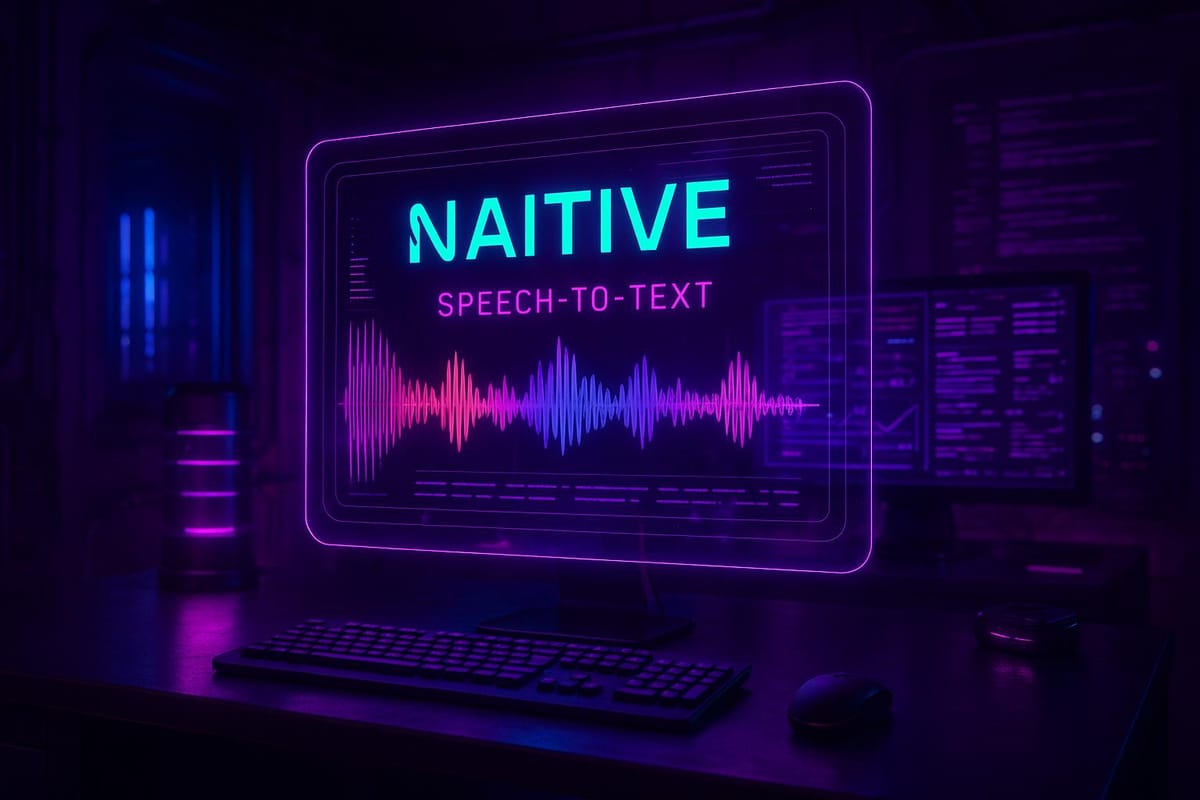Ultimate Guide to Open-Source Speech-to-Text
Explore how open-source speech-to-text tools enhance business efficiency, cost savings, and compliance through customizable voice data solutions.

Open-source speech-to-text (STT) tools are reshaping how businesses handle voice data. They offer cost savings, customization, and compliance advantages over proprietary solutions. Here's what you need to know:
-
Why Open-Source?
These tools provide flexibility, transparency, and the ability to train models on your own data. They avoid vendor lock-in and recurring fees, making them ideal for enterprises managing sensitive data or meeting regulatory requirements. -
Top Frameworks:
- Whisper: Multilingual, highly accurate, but GPU-intensive.
- Wav2Vec 2.0: Excels in clean audio, ideal for English-focused applications.
- SpeechBrain: Versatile with many pre-trained models, great for research and conversational AI.
- Coqui STT: Community-driven, CPU-friendly, and cost-effective.
- Vosk: Lightweight, real-time transcription for edge devices.
- Kaldi: Highly customizable but complex to set up.
-
Business Applications:
From real-time transcription in meetings to call center automation and accessibility tools, STT frameworks help enterprises streamline workflows, reduce costs, and meet compliance standards like HIPAA. -
Implementation Tips:
Use robust hardware (e.g., GPUs for Whisper), fine-tune models for industry-specific needs, and deploy scalable systems with Kubernetes for peak efficiency.
Key Takeaway: Open-source STT frameworks are a practical choice for businesses seeking control, cost efficiency, and compliance in voice technology. With expert guidance, they can be tailored to meet specific goals.
Best Free Speech-To-Text APIs and Open Source Libraries
Main Open-Source Speech-to-Text Frameworks
Open-source speech-to-text frameworks have become strong contenders to proprietary solutions, offering scalable and customizable options for everything from real-time transcription to complex voice automation systems. These tools provide the building blocks for creating robust voice processing applications tailored to specific needs.
Key Frameworks and Their Features
OpenAI Whisper stands out as a multilingual powerhouse. Licensed under MIT, it supports nearly 100 languages and was trained on an impressive dataset of 680,000 hours of audio. This extensive training enables it to handle diverse accents, background noise, and even technical jargon with precision. U.S. enterprises often leverage Whisper for large-scale transcription projects, multilingual meeting documentation, and industries where accuracy is critical for compliance. However, its high computational demands mean organizations need strong GPU infrastructure to achieve optimal performance.
SpeechBrain is a versatile framework built on PyTorch. It supports over 20 tasks related to speech and text processing and offers access to more than 200 training recipes and 100+ pretrained models via HuggingFace. Its modular structure makes it a go-to choice for conversational AI applications and research-focused environments. While its flexibility is a major plus, the quality of its models can vary depending on the task, requiring thorough testing before deployment.
Wav2Vec 2.0, developed by Meta, excels in environments with clean audio. It achieves a word error rate of 1.8% on clean data and 3.3% in more challenging conditions. This framework is ideal for organizations building custom speech-to-text APIs or needing real-time transcription capabilities. However, it demands technical expertise for setup and fine-tuning, making it better suited for teams with specialized knowledge and specific use cases.
Coqui STT builds on Mozilla's DeepSpeech and focuses on community-driven improvements. With flexible training pipelines and a transparent development process, it appeals to organizations that value collaboration and open development. Released under the Mozilla Public License 2.0, Coqui STT offers strong community support and regular updates, making it a solid choice for custom model development.
Kaldi remains a favorite among research institutions and organizations requiring extensive customization. Known for its modular architecture, Kaldi allows deep modifications to the speech recognition pipeline. However, this flexibility comes with a steep learning curve. Enterprises often choose Kaldi for specialized voice models or advanced speech processing research.
Vosk is a lightweight option designed for real-time transcription on edge devices without relying on GPUs. Its efficiency makes it well-suited for cost-sensitive applications like embedded systems and call center analytics. While its accuracy doesn’t match transformer-based models, Vosk shines in on-premises solutions where data privacy is a priority.
Each of these frameworks offers unique strengths, but their licensing terms and community support play a significant role in determining their suitability for enterprise use.
Licensing and Community Support
While features are crucial, enterprise-friendly licensing and active community ecosystems are equally important for long-term success. Most major frameworks use permissive licenses that allow commercial deployment and modification. For example, MIT License (Whisper) and Apache 2.0 (Vosk, Kaldi, SpeechBrain) are widely adopted and impose minimal restrictions on commercial use. Coqui STT, under the Mozilla Public License 2.0, requires modifications to be open-sourced but still supports commercial applications.
Community support varies across frameworks and significantly impacts their long-term usability. SpeechBrain benefits from academic backing, active forums, and detailed documentation. Coqui STT focuses on addressing practical deployment challenges with a responsive and engaged community. Whisper, with its growing popularity, has fostered a broad ecosystem of third-party tools and integrations, simplifying troubleshooting and implementation.
A strong community presence ensures faster problem-solving, regular updates, and access to shared resources like pretrained models and integration tools. These elements are critical for organizations tackling deployment challenges or requiring specialized features. By avoiding vendor lock-in, open-source frameworks empower enterprises to adapt and scale solutions to meet evolving needs.
For businesses navigating the complexities of selecting and deploying these frameworks, NAITIVE AI Consulting Agency offers specialized guidance. Their expertise in advanced AI systems and voice automation ensures that enterprises can implement solutions that align with both operational goals and compliance standards.
Implementation: Setup, Customization, and Deployment
Deploying speech-to-text (STT) solutions in an enterprise setting requires a solid infrastructure, tailored adjustments, and a scalable system designed to meet U.S. business needs and compliance standards. With the framework selected, the next steps focus on setting up, customizing, and deploying the solution to align with enterprise goals.
Setup Requirements and Steps
For enterprise-level performance, modern open-source STT frameworks demand powerful hardware. A recommended setup includes Linux servers equipped with at least 16 GB of RAM, multi-core CPUs, and NVIDIA GPUs. You’ll also need Python 3.8+ and frameworks like PyTorch or TensorFlow, along with libraries such as NumPy, SciPy, librosa, and soundfile.
To ensure consistency in deployment and manage dependencies effectively, use containers like Docker. Pair this with Kubernetes for automatic scaling and high availability, enabling the STT service to handle fluctuating workloads while maintaining steady response times during peak usage.
Initial setup involves configuring the language model for American English, defining input and output formats, and integrating the system with enterprise authentication protocols. Secure data storage is critical - implement audit logging and data retention policies to meet compliance requirements.
Customization for Business Needs
Generic STT models often fall short when dealing with industry-specific jargon or regional accents common in U.S. workplaces. Fine-tuning the model with domain-specific datasets - like transcribed calls, meetings, or industry documents - helps bridge this gap.
For example, healthcare organizations frequently enhance models using HIPAA-compliant medical transcripts to improve recognition of pharmaceutical terms, medical procedures, and clinical vocabulary. Similarly, other industries can train models to handle unique terminology and accents using transfer learning techniques.
Some frameworks even allow dynamic loading of accent-specific acoustic models, enabling real-time adjustments based on speaker characteristics. To maintain accuracy, regularly test the system with diverse datasets that reflect regional and industry-specific variations. Establish feedback loops to collect and analyze transcription errors, using this data to refine the model over time.
Deployment Best Practices
A scalable system is the backbone of any successful enterprise STT deployment. Using Kubernetes for container orchestration ensures the system can scale automatically based on demand, while load balancers distribute requests across multiple service instances. After customizing the model, follow these best practices to ensure smooth operation.
Track key metrics like latency, error rates, and resource usage, and set up automated alerts for performance issues. Real-time dashboards can help operations teams quickly identify and address problems before they affect users.
Managing data pipelines involves creating workflows for ingesting, processing, and storing audio content. Automated quality checks should verify audio format, duration, and clarity before processing. If transcriptions fail, fallback procedures and human review processes can help maintain service reliability.
To ensure business continuity, implement geographic redundancy, automated failover systems, and regular data backups. Many U.S. organizations rely on primary and secondary data centers to minimize downtime during outages or maintenance.
Compliance is another critical aspect. For HIPAA-covered entities, this means encrypted data transmission, access logging, and secure deletion protocols. Educational institutions, on the other hand, must handle data in ways that comply with FERPA standards.
Continuous performance optimization is essential. Regularly update models and use rollback capabilities to minimize downtime during updates. Automated testing pipelines should validate new model versions against established benchmarks, giving organizations the ability to adopt community-driven improvements without sacrificing stability.
For enterprises seeking expert assistance, NAITIVE AI Consulting Agency offers specialized guidance. Their expertise in AI agents and voice automation ensures seamless integration of STT solutions with existing business processes, while adhering to compliance and performance standards.
Comparison of Leading Open-Source STT Frameworks
This section breaks down the performance, technical demands, and costs of leading speech-to-text (STT) frameworks. Each option comes with its own strengths and compromises, shaping factors like accuracy, deployment expenses, and long-term upkeep for U.S.-based enterprises. This analysis builds on earlier discussions about business priorities and compliance, helping organizations choose the best fit for their goals.
OpenAI Whisper stands out for its versatility. Trained on an impressive 680,000 hours and supporting 98 languages, it delivers strong performance even in noisy environments. However, it requires substantial GPU resources to operate effectively. Its MIT license allows broad flexibility for commercial use.
Wav2Vec 2.0 shines in clean audio conditions, achieving a stellar 1.8% word error rate on the LibriSpeech test-clean dataset. However, its focus on English limits its appeal for multilingual applications, making it a better fit for enterprises with predominantly English-speaking operations.
SpeechBrain is an all-in-one toolkit for various speech processing tasks. It offers over 200 training recipes and a library of more than 100 pre-trained models available on HuggingFace. Backed by a strong academic community, it benefits from regular updates and reliable documentation.
Coqui STT continues the legacy of Mozilla DeepSpeech, driven by community contributions. While its accuracy lags behind transformer-based models, its lower hardware requirements and CPU-optimized performance make it a practical choice for cost-sensitive deployments.
Vosk is tailored for edge computing and real-time applications, excelling in scenarios where low latency is essential. It runs efficiently on standard CPUs, making it ideal for distributed setups and resource-limited environments.
Comparison Table of Frameworks
Here’s a quick overview of key metrics for each framework:
| Framework | Word Error Rate | Languages | Real-Time Factor | Hardware Needs | License | Key Cost Factors |
|---|---|---|---|---|---|---|
| Whisper (large-v3) | 2.7% (clean), 5.6% (noisy) | 98 | 0.5–1.0x (GPU) | High (GPU required) | MIT | GPU infrastructure, cloud compute |
| Wav2Vec 2.0 | 1.8% (clean), 3.3% (noisy) | Primarily English | 0.5–1.0x (GPU) | High (GPU preferred) | Apache 2.0 | Training costs, specialized hardware |
| SpeechBrain | 2.0–3.0% | 20+ supported | 1.0x (GPU/CPU) | Moderate | Apache 2.0 | Development time, customization |
| Coqui STT | 5–10% typical | 10+ available | <1.0x (CPU) | Low–moderate | MPL 2.0 | Community support, model training |
| Vosk | 6–8% range | 20+ models | <1.0x (CPU) | Low (CPU only) | Apache 2.0 | Edge deployment, minimal infrastructure |
Both Vosk and Coqui STT can run on standard server hardware, cutting infrastructure costs by 60–80% compared to GPU-heavy frameworks.
For enterprises seeking expert advice on selecting and deploying the right framework, NAITIVE AI Consulting Agency offers tailored consulting services. Their expertise in AI-driven voice solutions and process automation helps businesses navigate technical challenges while ensuring compliance with U.S. regulations.
Whisper benefits from widespread adoption and ongoing development, SpeechBrain thrives on academic support with frequent updates and comprehensive documentation, and Coqui STT relies on community innovation, which can sometimes lack the consistency of corporate-backed alternatives. These insights aim to help enterprises pinpoint the framework that aligns with their operational needs and budget constraints.
Advanced Use Cases and Customization in Enterprise AI
Open-source speech-to-text (STT) technology offers a flexible and scalable foundation for enterprise applications, unlocking ways to optimize business operations. From autonomous customer service to ensuring regulatory compliance, these advanced implementations can be tailored to meet specific organizational needs. Let’s explore three impactful enterprise use cases.
AI-Powered Voice and Phone Agents
Autonomous voice agents are one of the most impactful applications of open-source STT. By integrating tools like SpeechBrain or Whisper with natural language understanding, businesses can handle complex customer interactions around the clock. For example, SpeechBrain, built on PyTorch, allows companies to fine-tune models using their own customer data, improving recognition of industry-specific language.
A U.S. healthcare provider successfully implemented Whisper to automate patient call transcriptions, reducing workload and improving accuracy. Similarly, financial services firms have used SpeechBrain for secure, real-time transcription of compliance-related calls, helping meet regulatory standards while maintaining efficiency.
NAITIVE AI Consulting Agency has carved out a niche in creating voice agents that are virtually indistinguishable from human operators. By blending cutting-edge AI with real-world business needs, they deliver solutions that achieve measurable outcomes.
Real-Time Meeting and Workflow Integration
Real-time transcription is revolutionizing team collaboration and productivity in modern enterprises. Tools like Wav2Vec 2.0, with its low word error rate of 1.8% on clean audio, are ideal for structured meeting environments. Meanwhile, Whisper’s multilingual support makes it a great fit for global teams. For successful implementation, enterprises need robust GPU resources, secure data handling, and seamless integration with platforms like Zoom or Microsoft Teams.
Advanced setups go beyond transcription, automatically generating meeting summaries and extracting key action items. This reduces administrative overhead, creates searchable records, and enables faster decision-making across organizations.
Accessibility and Compliance Solutions
Beyond improving productivity, STT technology plays a vital role in accessibility and compliance. Open-source frameworks help U.S. enterprises meet Americans with Disabilities Act (ADA) requirements by providing accessible communication tools for employees and customers with hearing impairments. These tools include real-time captions, automated transcripts, and voice navigation systems. Whisper’s multilingual capabilities support diverse teams, while SpeechBrain’s customization options allow optimization for unique speech patterns and integration with assistive technologies.
Accessibility solutions not only ensure legal compliance but also improve the overall user experience. By automating processes, enterprises can reduce costs, enhance customer satisfaction with faster response times, and boost productivity through streamlined communication. Additionally, open-source STT solutions offer benefits like data ownership and the ability to customize, giving businesses an edge over proprietary systems.
Conclusion and Next Steps
Open-source speech-to-text (STT) frameworks are reshaping how U.S. enterprises approach voice technology. They offer a powerful combination of data control, cost management, and customization. Throughout this guide, we've explored how tools like Whisper, SpeechBrain, and Wav2Vec 2.0 provide businesses with adaptable, cost-effective solutions tailored to unique operational needs.
The advantages are clear. Open-source STT eliminates recurring API fees, offering predictable costs, while enabling on-premises processing to meet compliance requirements for regulations like HIPAA and GDPR. For instance, companies such as Autoposting.ai have adopted these frameworks to ensure user audio data remains securely in-house.
From a technical standpoint, Whisper, Wav2Vec 2.0, and SpeechBrain deliver reliable, high-accuracy transcription solutions. These tools empower enterprises to deploy voice technology in structured and scalable ways.
To get started, businesses should first assess their transcription and automation needs. This includes evaluating factors like accuracy, language support, and available resources before piloting a solution.
"NAITIVE's AI business consulting transforms enterprises for the AI era. We analyze your operations, identify high-impact AI opportunities, and craft tailored strategies for implementation. Our experts guide you through AI adoption, from proof-of-concept to full-scale deployment, ensuring seamless integration with existing systems."
- NAITIVE AI Consulting Agency
Expert guidance can make all the difference. For example, John, CEO of NAITIVE AI Consulting Agency, shared that their Voice AI Agent solution managed 200 outbound calls daily, leading to a 34% boost in customer retention and a 41% increase in conversion rates. Similarly, Sarah Johnson, CXO, highlighted that an AI agent developed by NAITIVE now handles 77% of their L1–L2 client support tasks. These results demonstrate the measurable impact of tailored open-source STT systems.
To ensure success, enterprises must focus on rigorous testing and detailed documentation to seamlessly integrate these tools into their workflows.
The future of enterprise voice technology lies in open-source frameworks. As these tools continue to improve - offering greater accuracy, expanded multilingual support, and easier integration - early adopters will gain not only immediate cost savings but also a competitive edge in voice-enabled innovation. By combining cost efficiency, technical reliability, and operational effectiveness, open-source STT is paving the way for transformative voice solutions.
Interested in exploring how open-source STT can elevate your business operations? Reach out to NAITIVE AI Consulting Agency to craft a custom implementation strategy that delivers tangible results.
FAQs
How can businesses stay compliant with regulations like HIPAA when using open-source speech-to-text frameworks?
To comply with regulations like HIPAA when using open-source speech-to-text frameworks, businesses need to prioritize robust data security and privacy measures. This means encrypting sensitive data both during transmission and while it's stored, limiting access strictly to authorized personnel, and maintaining thorough audit logs to track data usage.
It's also crucial to assess whether the framework can meet compliance needs. Look for features like secure deployment options and tools for anonymizing or redacting protected health information (PHI). Partnering with legal and IT professionals who specialize in HIPAA can provide valuable guidance in implementing the necessary safeguards.
What should I consider when selecting an open-source speech-to-text framework for my business?
When choosing an open-source speech-to-text framework, there are a few critical aspects to keep in mind. Start by evaluating accuracy, processing speed, and the framework's ability to support multiple languages and accents. Another key consideration is how effectively it manages background noise, as this can be a game-changer in real-world applications. You'll also want to check if it integrates smoothly with your current systems or workflows.
Think about the framework's potential for customization and scalability, especially if your business requirements may shift or grow over time. If you're unsure where to begin or need specialized advice, NAITIVE AI Consulting Agency offers expert support to help you implement the right tools and create solutions tailored to your needs.
What’s the best way for businesses to integrate open-source speech-to-text tools into their current systems and workflows?
To integrate open-source speech-to-text tools into your current systems and workflows effectively, it’s important to align the technology with your specific business objectives. Working with experts, such as NAITIVE AI Consulting Agency, can make this process much easier. They focus on creating customized AI solutions, including AI automation and business process optimization, to ensure a smooth transition and improved efficiency.
With professional support, businesses can adapt open-source frameworks to meet unique requirements, simplify operations, and boost overall productivity.




